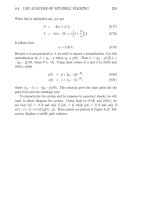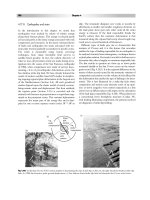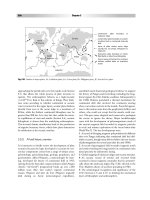Chemical Pollutants in Air, Water, Soil, and Solid Wastes Phần 8 pps
Bạn đang xem bản rút gọn của tài liệu. Xem và tải ngay bản đầy đủ của tài liệu tại đây (714.22 KB, 43 trang )
SULFUR DIOXIDE
Formula: SO
2
; MW 64.06; CAS [7446-09-5]; a major air pollutant; produced
when soft coals, oils, and automobile fuels burn; used as a fumigating and
bleaching agent; colorless gas with a strong suffocating odor; liquefies at –10°C;
solidifies at –72°C; soluble in water (8.5% at 25°C), alcohol, ether, and chloro-
form; highly toxic and a strong irritant.
AIR ANALYSIS
Air drawn through two 0.8
µ
m cellulose ester membranes: (1) the front filter to
collect any interfering particulate sulfate and sulfite in the air, and (2) the back
filter, treated with KOH to trap SO
2
; SO
2
converted to K
2
SO
3
on the back filter;
this filter treated with 10 mL mixture solution of 3 mmol NaHCO
3
and 2.4 mmol
Na
2
CO
3
; K
2
SO
3
dissociates into SO
3
2–
anion, which is then determined by ion
chromatography (NIOSH Method 6004, 1989); recommended flow rate
1 L/min; sample volume 100 L.
• Use SO
3
2–
calibration standard to determine the mass of SO
3
2–
; a blank
analysis performed on the media blanks for background correction.
• Multiply SO
3
2–
concentration by the stoichiometric factor 0.8 to calculate
the concentration of SO
2
.
• Bicarbonate-carbonate eluant of the back filter may also be oxidized with
a drop of 30% H
2
O
2
to SO
4
2–
; SO
4
2–
formed measured by ion chromatog-
raphy; to calculate the concentration of SO
2
, multiply the mass of SO
4
2–
found in the analysis, multiplied by the stoichiometric factor 0.667.
Alternatively, air drawn through an impinger solution containing 0.3
N
H
2
O
2
; SO
2
converted to SO
4
2–
which is measured by titration with NaOH or barium per-
chlorate (NIOSH Method S308, 1978).
Alternatively, air drawn though a solid sorbent tube containing molecular sieve
5A; SO
2
adsorbed on this trap desorbed on heating under He purge; transported
onto GC column and determined by GC/MS.
• Characteristic mass for SO
2
is 64.
3.64
© 1997 by CRC Press LLC
© 1997 by CRC Press LLC
412 HANDBOOK OF ENVIRONMENTAL ANALYSIS
A passive colorimetric dosimeter tube may also be used for direct measurement;
SO
2
diffuses into the tube; color changes (red-purple to yellow in Vapor Guard
tube); concentration determined from the length of stain.
•Temperature and relative humidity may affect measurement; tubes should
be used between 15 and 40°C.
(1 ppm SO
2
= 2.62 mg/m
3
at NTP)
© 1997 by CRC Press LLC
© 1997 by CRC Press LLC
412
TETRACHLORETHYLENE
Synonyms: perchloroethylene, tetrachloroethene, ethylene tetrachloride; For-
mula: Cl
2
C=CCl
2
; MW 165.82; CAS [127-18-4]; used in dry cleaning and metal
degreasing; colorless liquid with ether-like odor; boils at 121°C; freezes at –22°C;
vapor pressure 19 torr at 25°C; density 1.62 g/mL at 20˚C; insoluble in water;
miscible with organic solvents.
ANALYSIS OF AQUEOUS AND NONAQUEOUS SAMPLES
Aqueous samples extracted by purge and trap method; analyte thermally desorbed
out of trap and swept onto a GC column for separation from other volatile
compounds; detected by HECD, ECD, FID, or MSD.
Soils, solid wastes, or sludges mixed with water or methanol; the aqueous extract
or a solution of methanol extract spiked into water; subjected to purge and trap
concentration and analyzed as above.
Methanol or hexane extract may be directly injected for GC (ECD or FID) or
GC/MS determination.
• Characteristic masses for GC/MS identification: 164, 129, 131, and 166.
• Limit of detection: in the range 0.05
µ
g/L when detected by HECD for a
5-mL sample aliquot (subject to matrix interference).
• Recommended surrogate/IS: 2-bromo-1-chloropropane and 1,4-dichloro-
butane.
• Samples collected in glass/plastic containers without headspace, refriger-
ated, and analyzed within 14 days.
See Halogenated Hydrocarbons, Chapter 2.9 for GC columns and conditions and
a further discussion.
AIR ANALYSIS
Adsorbed over coconut charcoal (100 mg/50 mg); desorbed with CS
2
and analyzed
by GC-FID (NIOSH Method 1003, 1987); recommended flow rate 100 mL/min;
sample volume 3 L.
3.65
© 1997 by CRC Press LLC
© 1997 by CRC Press LLC
414 HANDBOOK OF ENVIRONMENTAL ANALYSIS
Adsorbed over Tenax (~2 g) in a cartridge; desorbed by heating under He purge;
transferred into a cold trap and then to the front of a GC column at –70°C;
column heated; analyte detected by ECD or MSD (U.S. EPA Method TO-1);
recommended flow rate 100 mL/min; sample volume 10 L.
Adsorbed over carbon molecular sieve (~400 mg) in a cartridge; heated at 350°C
under He purge; transferred into a cryogenic trap and flash evaporated onto a
capillary column GC/MS (U.S. EPA Method TO-2); recommended flow rate 1
L/min; sample volume 100 L.
Collected in a trap in liquid argon; the trap removed and heated; sample transferred
to a precooled GC column for ECD or FID detection (U.S. EPA Method TO-3).
Collected in a SUMMA passivated canister under pressure using an additional
pump or at subatmospheric pressure by initially evacuating the canister; the air
transferred into cryogenically cooled trap attached to a GC column; the trap
heated; the analyte separated on the column for detection by ECD or GC/MS
(U.S. EPA Method TO-14).
(1 ppm tetrachloroethylene in air = ~6.8 mg/m
3
at NTP)
© 1997 by CRC Press LLC
© 1997 by CRC Press LLC
414
TETRAETHYLLEAD
Synonym: tetraethylplumbane, lead tetraethyl; Formula: Pb(C
2
H
5
)
4
; MW
323.47; CAS [78-00-2]; used in motor gasoline as an additive to prevent “knock-
ing”; such an application, however, is currently curtailed because of environmen-
tal pollution; boils at 200°C; vapor pressure 0.2 torr at 20°C; density 1.653 g/mL
at 20°C; insoluble in water; slightly soluble in alcohols; dissolves in benzene,
toluene, hexane, petroleum ether, and gasoline; highly toxic (Patnaik, 1992).
ANALYSIS OF AQUEOUS AND NONAQUEOUS SAMPLES
Aqueous samples may be microextracted with toluene, benzene, or hexane and the
extract analyzed by GC/MS.
• The m/z of primary characteristic ion 237; the secondary ions for compound
identification 295, 208, 235, and 266 (electron impact ionization); peak
intensity ratios for m/z 237:295:208 = 100:73:61 (Hites, 1992).
• GC column: a fused silica capillary column such as DB-5, SPB-5, Rtx-5,
or equivalent.
Soils, sediments, or other nonaqueous matrices mixed with anhydrous Na
2
SO
4
and
extracted by sonication; the solvent extract analyzed as above by GC/MS.
• If lead analysis is performed by AA spectrophotometry, following acid
digestion of samples, then the stoichiometric calculation for tetraethyllead
(TEL) may be done as follows:
conc. of TEL = conc. of Pb
×
1.56
(assuming all Pb in sample occurs as TEL; such an assumption, however,
could be erroneous.)
3.66
© 1997 by CRC Press LLC
© 1997 by CRC Press LLC
TETRAETHYL PYROPHOSPHATE
Synonyms: pyrophosphoric acid tetraethyl ester, TEPP; Formula: C
8
H
20
O
7
P
2
;
Structure:
MW 290.19; CAS [107-49-3]; an organophosphorus pesticide; colorless
liquid; hygroscopic; boiling point 124°C at 1 mm Hg; vapor pressure 0.00047 torr
at 20°C; decomposes at 170 to 213°C; density 1.185 g/ml at 20°C; miscible with
most organic solvents; miscible with water but rapidly hydrolyzed; highly toxic.
ANALYSIS OF AQUEOUS AND NONAQUEOUS SAMPLES
Aqueous samples (TEPP unstable) extracted serially with methylene chloride; the
extract concentrated and analyzed by GC/MS.
• Characteristic masses for GC/MS identifications: 99, 155, 127, 81, and 109.
• GC column: a fused silica capillary column, such as DB-5 or equivalent.
Soil, sediment, or solid waste sample mixed with anhydrous Na
2
SO
4
; sonicated or
Soxhlett extracted with methylene chloride; extract concentrated and analyzed
by GC/MS as above.
AIR ANALYSIS
Air drawn through a solid sorbent tube containing Chromosorb 102 (100 mg/
50 mg); analyte desorbed with 1 ml toluene (on 60 min standing); toluene
extract analyzed by GC-FPD (NIOSH method 2504, 1984); recommended flow
rate 0.1 L/min; sample volume 20 L.
CH
3
CH
2
O
P
O
CH
2
CH
3
O
OP
O
O
O
CH
2
CH
3
CH
2
CH
3
3.67
© 1997 by CRC Press LLC
© 1997 by CRC Press LLC
418 HANDBOOK OF ENVIRONMENTAL ANALYSIS
• GC column: Super-Pak 20M or equivalent.
• Calibration standards are made from TEPP in toluene.
• The working range of the method was determined to be 0.025 to 0.15 mg/m
3
for a 40 L sample.
(1 ppm TEPP in air = 11.86 mg/m
3
at NTP)
© 1997 by CRC Press LLC
© 1997 by CRC Press LLC
418
TETRAHYDROFURAN
Synonyms: oxolane, 1,4-epoxybutane, oxacyclopentane; Formula: C
4
H
8
O;
Structure:
MW 72.12; CAS [109-99-9]; used as a solvent; colorless liquid; ether-like
odor; boils at 66°C; vapor pressure 145 torr at 20°C; freezes at –188.5°C; density
0.89 g/ml at 20°C; miscible with water and most organic solvents; highly flam-
mable.
ANALYSIS OF AQUEOUS SAMPLES
Aqueous samples extracted by purge and trap method; the sorbent trap heated and
back flushed with He to transfer the analyte onto a capillary GC column
interfaced to a mass spectrometer; determined by GC/MS.
• Because of high solubility of tetrahydrofuran in water, its purging efficiency
is low. The purging vessel should be heated.
• The characteristic masses for GC/MS identification: 71 (primary), 72, and
42.
• GC column: a fused silica capillary column such as DB-624, 75 m
×
0.53 mm
×
3 mm, or equivalent.
Alternatively, aqueous samples directly injected onto the GC column for FID
determination.
• The detection range on FID without sample concentration is several order
higher than the purge and trap method (under heating or purging vessel).
• No precision and accuracy data are available for both the above methods.
H
2
C
H
2
C
O
CH
2
CH
2
3.68
© 1997 by CRC Press LLC
© 1997 by CRC Press LLC
420 HANDBOOK OF ENVIRONMENTAL ANALYSIS
AIR ANALYSIS
Air drawn through a solid sorbent tube containing coconut shell charcoal (100 mg/
50 mg); analyte desorbed into 0.5 mL CS
2
(on 30 min contact time); the CS
2
extract analyzed by GC-FID (NIOSH method 1609, 1985); recommended air
flow rate 0.1 L/min; sample volume 5 L.
• GC column: stainless steel column packed with Porapak Q (50/80 mesh).
A fused silica capillary column such as DBWAX or DB-624 may also be
used.
• High humidity may affect the measurement.
•For a 5 L air sample, working range of the method was determined to be
100 to 2600 mg/m
3
.
(1 ppm tetrahydrofuran in air = 2.95 mg/m
3
at NTP)
© 1997 by CRC Press LLC
© 1997 by CRC Press LLC
420
TOLUENE
Synonyms: methylbenzene, phenylmethane. Formula: C
7
H
8
; Structure:
MW 92.15; CAS [108-88-3]; occurs in gasoline, petroleum solvents, and
coal-tar distillates; used as a solvent and in many organic syntheses; colorless
liquid with a characteristic aromatic odor; boils at 110.7°C; freezes at –95°C;
vapor pressure 22 torr at 20°C; density 0.866 g/mL at 20°C; slightly soluble in
water (0.63 g/L at 25°C); readily miscible with organic solvents.
ANALYSIS OF AQUEOUS AND NONAQUEOUS SAMPLES
Purge and trap method; toluene bound onto the trap, thermally desorbed from the
sorbent trap, and swept by an inert gas onto a GC column for separation from
other volatile compounds; detected by PID, FID, or a mass spectrometer.
Solid samples mixed with water or methanol; the aqueous extract or a portion of
methanol extract spiked into water; subjected to purge and trap concentration
and analyzed as above.
Alternatively, toluene thermally desorbed from the solid sample under He purge
(without any solvent treatment) and analyzed by GC or GC/MS as above.
• Characteristic masses for GC/MS identification: 91, 92, 39, 65; peak ratios
91:92:39:65 = 100:73:20:14 (Hites, 1992).
• Limit of detection: in the range 0.5
µ
g/L when detected by PID for a 5-mL
sample volume (subject to matrix interference).
• GC column: a nonpolar fused silica capillary column, such as DB-5,
SPB-5, VOCOL, or equivalent.
• Recommended surrogate/IS: toluene d
7
and fluorobenzene.
CH
3
3.69
© 1997 by CRC Press LLC
© 1997 by CRC Press LLC
422 HANDBOOK OF ENVIRONMENTAL ANALYSIS
• Samples collected in glass containers without headspace, refrigerated, and
analyzed within 7 days; samples preserved with 1:1 HCl (0.2 mL acid/40
mL sample) may be analyzed in 14 days.
Air drawn through a sorbent tube containing coconut shell charcoal (100 mg/
50 mg); analyte desorbed into CS
2
over 30 min. standing; analyzed by GC-FID
(NIOSH Method 1501, 1984); recommended flow rate 200 mL/min; sample
volume 20 L.
• GC column: packed column 10% OV-275 on Chromosorb W-AW
(100/120 mesh), Porapak P 50/80 mesh, or equivalent.
Air drawn through a cartridge containing Tenax (~2 g); cartridge heated under He
purge; toluene transported into a cold trap and then to the front of a GC column
at –70°C; column heated; toluene determined by GC/MS (U.S. EPA Method
TO-1); recommended flow rate 100 mL/min; sample volume 10 L.
Air passed through a cartridge containing carbon molecular sieve (~400 mg);
cartridge heated at 350°C under He purge; analyte carried into a cryogenic trap
and flash evaporated onto a capillary column; determined by GC/MS (U.S. EPA
Method TO-2); recommended flow rate 1 L/min; sample volume 100 L.
Collected in a trap in liquid argon; the trap removed and heated; sample transferred
to a precooled GC column for PID or FID detection (U.S. EPA Method TO-3).
(1 ppm toluene in air = 3.76 mg/m
3
at NTP)
© 1997 by CRC Press LLC
© 1997 by CRC Press LLC
422
TOLUENE-2,4-DIISOCYANATE
Synonyms: 2,4-diisocyanatotoluene, TDI, isocyanic acid 4-methyl-
m
-phenylene
ester; Formula: CH
3
C
6
H
3
(NCO)
2
; Structure:
MW 174.16; CAS [584-84-9]; used in the production of urethane foams,
elastomers, and coatings; also commercially available as a mixture of 2,4- and
2,6-isomers; colorless liquid or solid; turns dark on exposure to light; pungent
fruity odor; boils at 238°C; melts at 20.5°C (80:20 mixture of the isomers melts
at 13°C); density 1.22 g/mL; decomposes with water and alcohol; soluble in most
organic solvents; highly toxic.
ANALYSIS OF AQUEOUS AND NONAQUEOUS SAMPLES
Sample extracted with methylene chloride; extract concentrated and analyzed by
GC/MS.
• The characteristic masses for compound identification: 174, 145, 173, 146,
132, and 91.
Alternatively, sample extracted with toluene; extract treated with
N
-4-nitrobenzyl-
N
-propylamine (derivatizing agent) in toluene; TDI forms an urea derivative;
the derivative extracted with acetonitrile and the extract solution then analyzed
by HPLC-UV at 272 nm.
• The method originally developed for air analysis (Tiesler and Eben, 1985);
no data available on precision and accuracy study for aqueous or solid
matrices.
CH
3
NCO
NCO
3.70
© 1997 by CRC Press LLC
© 1997 by CRC Press LLC
424 HANDBOOK OF ENVIRONMENTAL ANALYSIS
• HPLC column and conditions: column packing: RP-8 or RP-18 (10 mm);
temperature: ambient; mobile phase: acetonitrile-water; gradient program:
from 30% acetonitrile to 60% in 15 min; 5 min isocratic; flow rate
1.5 mL/min.
•For quantitation, prepare a calibration standard, plotting the concentration
of urea derivative of each reference standard against peak areas.
• Derivatizing agent prepared as follows: 50 g 4-nitrobenzyl chloride in
250 mL toluene heated under reflux; 36 g
n
-propylamine added dropwise
in 30 min; refluzed for 5 h; solvent removed at 50°C on a rotary evaporator;
residue treated with 80 mL water followed by slow addition of 30 mL
NaOH 40%; the alkaline solution extracted with 100 mL toluene; extract
treated with 2 g charcoal and then filtered. The derivatizing agent prepared
above is stable for 2 to 3 days. It may be converted into its hydrochloride
as follows (which may be stable for several months):
Excess solvent and
n
-propylamine removed on a rotary evaporator;
product dissolved in 50 mL acetone; 35 mL conc. HCl added; mixture dried
at 50°C; hydrochloride repeatedly washed with acetone-toluene (1:1); the
salt desiccated in the vacuum oven.
Hydrochloride may be converted back to the free amine derivatizing
agent prior to use. This may be done by dissolving the salt in water, then
adding 1
N
NaOH soln. and extracting the free amine into toluene. The
toluene phase is dried with Na
2
SO
4
and then diluted to 250 mL. The
concentration of this amine solution is 0.002
M
(Soln. A). This may be
tenfold diluted to give 0.0002
M
amine solution (Soln. B).
AIR ANALYSIS
Air drawn through glass wool coated with
N
-[(4-nitropheny)methylpropylamine;
derivative desorbed into 2 mL methanol in ultrasonic bath; analyzed by HPLC
using an UV detector at 254 nm (NIOSH Method 2535, 1987); recommended
flow rate 0.5 L/min; sample volume 50 L.
• Derivative stable for 14 days if protected from light.
• HPLC column: Octadecylsilylated silica (5
µ
m).
(1 ppm TDI = 7.12 mg/m
3
at NTP)
© 1997 by CRC Press LLC
© 1997 by CRC Press LLC
424
o
-TOLUIDINE
Synonyms: 2-methylaniline, 2-methylbenzenamine, 2-aminotoluene,
o
-toly-
lamine; Formula: C
7
H
7
NH
2
; Structure:
MW 107.17; CAS [95-53-4]; used in the manufacture of various dyes and
as an intermediate in rubber chemicals and pharmaceuticals; colorless liquid,
becoming yellowish to reddish-brown on exposure to air or light; boils at 200°C;
solidifies at –16°C; vapor pressure 0.1 torr at 20°C; slightly soluble in water
(1.5% at 20°C), readily miscible in organic solvents; carcinogenic and toxic at
high doses (Patnaik, 1992).
ANALYSIS OF AQUEOUS AND NONAQUEOUS SAMPLES
Aqueous samples made alkaline with NaOH to pH >12 and extracted with meth-
ylene chloride; analyte partitions into the organic phase; the organic extract
concentrated and analyzed by GC/NPD or GC/MS.
• GC column: Packed –3% SP-2250 on Supelcoport, Chromosorb-103, or
equivalent; capillary: fused silica capillary column such as DB-5, PTE-5,
or other equivalent.
• Characteristic masses for GC/MS identification: 107 and 106.
Solid matrices mixed with anhydrous Na
2
SO
4
followed by methylene chloride;
sonicated; extract cleaned by acid-based partitioning and analyzed by GC-NPD,
GC-FID, or GC/MS.
• Aqueous and nonaqueous samples should be stored at 4°C, extracted within
7 days of collection, and analyzed within 40 days from extraction.
NH
2
CH
3
3.71
© 1997 by CRC Press LLC
© 1997 by CRC Press LLC
426 HANDBOOK OF ENVIRONMENTAL ANALYSIS
AIR ANALYSIS
Analyte adsorbed over silica gel (150/15 mg); desorbed into 95% ethanol in an
ultrasonic bath and analyzed by GC-FID or GC-NPD (NIOSH Method 2002,
1985); recommended flow rate 200 mL/min; sample volume 20 to 30 L.
• Adsorption efficiency of silica gel decreases under high humidity.
•
o
-Toluidine stable on silica gel at least for one week.
• Sensitivity is much greater on GC-NPD.
(1 ppm
o
-toluidine in air = ~4.4 mg/m
3
at NTP)
© 1997 by CRC Press LLC
© 1997 by CRC Press LLC
426
1,1,1-TRICHLOROETHANE
Synonyms: methyl chloroform, strobane; Formula: C
2
H
3
Cl
3
; Structure:
H
3
C–CCl
3
; MW 133.40; CAS [71-55-6]; used as a cleaning solvent; colorless
liquid with a mild chloroform-like odor; boils at 74°C; vapor pressure 100 torr
at 20°C; freezes at –32.5°C; density 1.34 g/mL at 20°C; very slightly soluble in
water (~70 mg/L); soluble in organic solvents.
ANALYSIS OF AQUEOUS AND NONAQUEOUS SAMPLES
Analyte in aqueous samples extracted by purge and trap method; volatile com-
pounds thermally desorbed and swept onto a GC column for separation;
detected by HECD, ECD, or MSD.
Soils, solid wastes, or sludges mixed with water or methanol; the aqueous extract
or a solution of methanol extract spiked into water; subjected to purge and trap
concentration and analyzed as above.
• Characteristic masses for GC/MS identification: 97, 99, 117, and 119.
• Limit of detection: in the range 0.05
µ
g/L when detected by HECD for a
5-mL sample aliquot (subject to matrix interference).
• Recommended surrogate/IS: bromochloromethane and 1,2-dichloro-
ethane d
4
.
• Samples collected in glass/plastic containers without headspace, refrigerated,
and analyzed within 14 days.
See Halogenated Hydrocarbons, Chapter 2.9 for GC columns and conditions and
a detailed discussion.
AIR ANALYSIS
Suggested method: adsorbed over coconut charcoal (100 mg/50 mg); desorbed
with CS
2
and analyzed by GC-FID; recommended flow rate 100 mL/min;
sample volume 10 L; precision and accuracy of the method not established.
3.72
© 1997 by CRC Press LLC
© 1997 by CRC Press LLC
428 HANDBOOK OF ENVIRONMENTAL ANALYSIS
Suggested method: adsorbed over carbon molecular sieve (~400 mg) in a cartridge;
heated at 350°C under He purge; transferred into a cryogenic trap and flash
evaporated onto a capillary column GC/MS; recommended flow rate 2 L/min;
sample volume 100 L; precision and accuracy of the method not known.
Collected in a SUMMA passivated canister under pressure using an additional
pump or at subatmospheric pressure by initially evacuating the canister; the air
transferred into cryogenically cooled trap attached to a GC column; the trap
heated; the analyte separated on the column for detection by ECD or GC/MS
(U.S. EPA Method TO-14).
© 1997 by CRC Press LLC
© 1997 by CRC Press LLC
428
TRICHLOROETHYLENE
Synonyms: trichloroethene, ethylene trichloride; Formula C
2
HCl
3
; Structure:
MW 131.38; CAS [79-01-6]; used in dry cleaning and degreasing; colorless
liquid with chloroform-like odor; boils at 87°C; freezes at –85°C; vapor pressure
58 torr at 20°C; density 1.46 g/mL at 20°C; very slightly soluble in water (about
1000 mg/L), miscible with organic solvents.
ANALYSIS OF AQUEOUS AND NONAQUEOUS SAMPLES
Aqueous samples extracted by purge and trap method; analyte thermally desorbed
and swept onto a GC column for separation from other volatile compounds;
detected by HECD, ECD, FID, or MSD.
Soils, solid wastes, or sludges mixed with water or methanol; the aqueous extract
or a solution of methanol extract spiked into water; subjected to purge and trap
concentration and analyzed as above.
Methanol extract may be directly injected for GC or GC/MS determination.
• Characteristic masses for GC/MS identification: 95, 97, 130, and 132.
• Limit of detection: in the range 0.1
µ
g/L when detected by HECD for a
5-mL sample aliquot (subject to matrix interference).
• Recommended surrogate/IS: 1,2-dichloroethane d
4
and 2-bromo-1-chloro-
propane.
• Samples collected in glass/plastic containers without headspace, refrigerated,
and analyzed within 14 days.
See Halogenated Hydrocarbons, Chapter 2.9 for GC columns and conditions and
further discussion.
H
C
Cl
C
Cl
Cl
3.73
© 1997 by CRC Press LLC
© 1997 by CRC Press LLC
430 HANDBOOK OF ENVIRONMENTAL ANALYSIS
AIR ANALYSIS
Adsorbed over coconut charcoal (100 mg/50 mg); desorbed with CS
2
; and analyzed
by GC-FID; recommended flow rate 100 mL/min; sample volume 5 L.
Adsorbed over carbon molecular sieve (~400 mg) in a cartridge heated at 350°C
under He purge; transferred into a cryogenic trap and flash evaporated onto a
capillary column GC/MS (U.S. EPA Method TO-2); 1 L/min recommended
flow rate; sample volume 100 L.
Collected in a trap in liquid argon; the trap removed and heated; sample transferred
to a precooled GC column for ECD or FID detection (U.S. EPA Method TO-3).
Collected in a SUMMA passivated canister under pressure using an additional
pump or at subatmospheric pressure by initially evacuating the canister; the air
transferred into cryogenically cooled trap attached to a GC column; the trap
heated; the analyte separated on the column for detection by ECD or GC/MS
(U.S. EPA Method TO-14).
(1 ppm trichloroethylene in air = 5.36 mg/m
3
at NTP)
© 1997 by CRC Press LLC
© 1997 by CRC Press LLC
430
2,4,6-TRICHLOROPHENOL
Formula: C
6
H
2
Cl
3
OH; Structure:
MW 197.46; CAS [88-06-2]; crystalline solid with strong phenolic odor;
melts at 69°C; boils at 246°C; insoluble in water; soluble in most organic solvents.
ANALYSIS OF AQUEOUS AND NONAQUEOUS SAMPLES
Aqueous samples pH adjusted below 2; extracted with methylene chloride; extract
concentrated and analyzed by GC-FID or GC/MS.
• Alternatively, extract exchanged into 2-propanol; derivatized with pentaflu-
orobenzyl bromide, and determined by GC-ECD.
• Aqueous samples may be analyzed by HPLC on an underivatized polysty-
rene-divinylbenzene column such as Poly-RP CO (Alltech 1995) or a C-18
reverse-phase column; gradient: acetonitrile and 0.01
M
K
3
PO
4
at pH 7
(55:45) and the analyte detected by UV at 254 nm.
Soils, solid wastes, and sludges extracted with methylene chloride by sonication,
Soxhlett, or supercritical fluid extraction; extract may be acid washed, concen-
trated, and analyzed by GC-FID, GC-ECD, or GC/MS as above.
• Characteristic masses for GC/MS determination: 196, 198, and 200 (elec-
tron impact ionization); 197, 199, and 201 (chemical ionization).
• Limit of detection: in the range 5 to 10
µ
g/L on FID or GC/MS and below
1
µ
g/L on ECD (for aqueous samples concentrated by 1000 times).
• Recommended surrogate/IS: pentafluorophenol and 2-perfluoromethyl
phenol.
OH
Cl Cl
Cl
3.74
© 1997 by CRC Press LLC
© 1997 by CRC Press LLC
432 HANDBOOK OF ENVIRONMENTAL ANALYSIS
• Sample collected in glass containers, refrigerated, and extracted within
7 days of collection and analyzed within 40 days of extraction.
See Phenols, Chapter 2.23 for GC columns and conditions.
AIR ANALYSIS
Not likely to occur in ambient air in vapor state; the vapor pressure too low.
Recommended Method: Airborne particles collected on a sorbent cartridge con-
taining polyurethane foam; deposited particles extracted with 5% diethyl ether
in hexane; extract analyzed by GC-ECD; recommended air flow 5 L/min;
sample volume 1000 L.
© 1997 by CRC Press LLC
© 1997 by CRC Press LLC
432
VINYL CHLORIDE
Synonyms: chloroethene, monochloroethylene; Formula: CH
2
=CHCl; MW
62.50; CAS [75-01-4]; used as a monomer to make PVC resins and plastics; a
colorless gas; liquefies at –13.4°C; slightly soluble in water; miscible in organic
solvents.
ANALYSIS OF AQUEOUS SAMPLES
Aqueous samples extracted by purge and trap method; analyte thermally desorbed
and swept onto a GC column for separation; detected by HECD, ECD, and
MSD.
• Characteristic masses for GC/MS identification: 62 and 64.
• Limit of detection: in the range 0.1
µ
g/L when detected by HECD for a
5-mL sample aliquot (subject to matrix interference).
• Recommended surrogate/IS: bromochloromethane and 1,2-dichloroethane d
4
.
• Samples collected in glass/plastic containers without headspace, refrigerated,
and analyzed within 14 days.
See Halogenated Hydrocarbons, Chapter 2.9 for GC columns and conditions and
for a detailed discussion.
AIR ANALYSIS
Adsorbed over carbon molecular sieve (~400 mg) in cartridge; heated at 350°C
under He purge; transferred into a cryogenic trap and flash evaporated onto a
capillary column GC/MS; recommended flow rate 100 mL/min; sample volume
10 L (U.S. EPA Method TO-2).
Collected in a trap in liquid argon; the trap removed and heated; sample transferred
to a precooled GC column for ECD detection (U.S. EPA Method TO-3).
Collected in a SUMMA passivated canister under pressure using an additional
pump or at subatmospheric pressure by initially evacuating the canister; the air
transferred into cryogenically cooled trap attached to a GC column; the trap
3.75
© 1997 by CRC Press LLC
© 1997 by CRC Press LLC
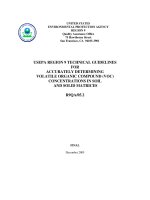
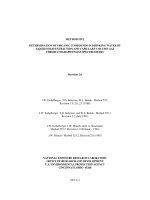
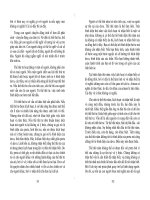
![Độc Học, Môi Trường Và Sức Khỏe Con Người [In lần 3] - Trịnh Thị Thanh phần 8 pot](https://media.store123doc.com/images/document/2014_08/02/medium_Z92TwJNPac.jpg)
